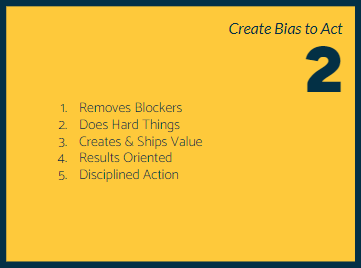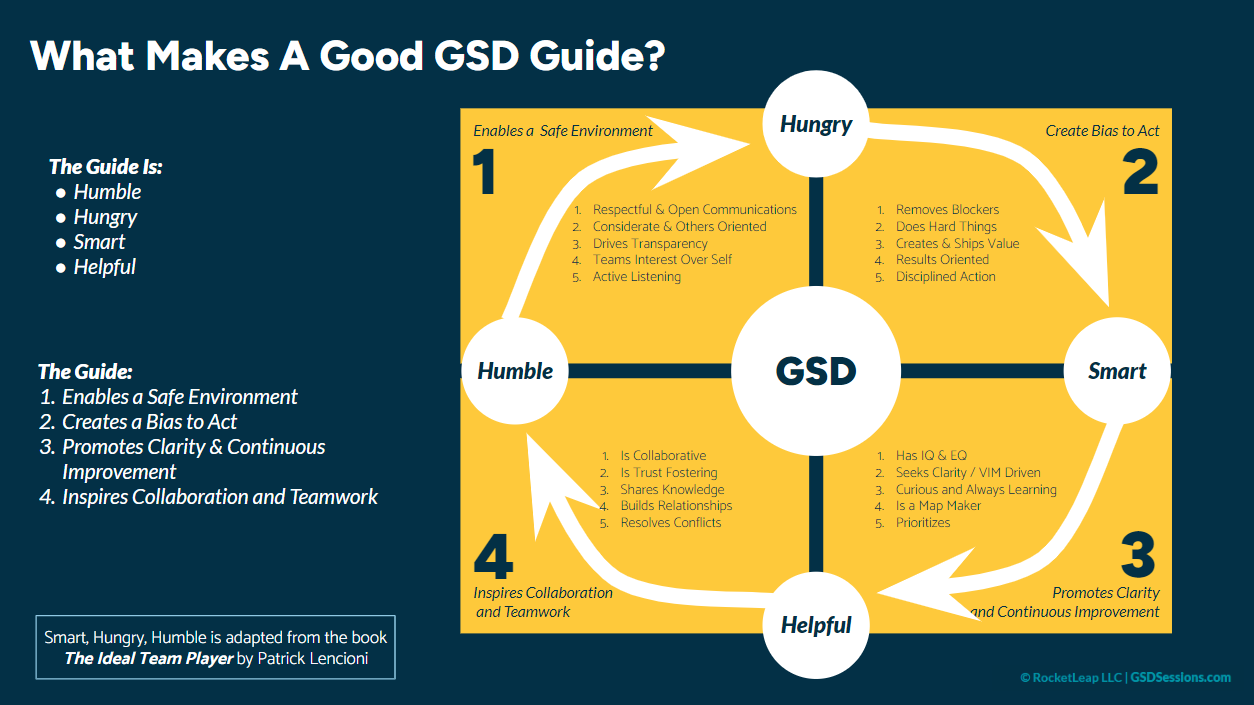The 4 Cornerstones of a GSD Guide
How to be the kind of person that creates incredible results in your team and company
Two questions, very different answers.
Who do you manage?
Who do you seek to serve?
In this regard, I see myself a servant leader, perhaps you do as well.
Or maybe you aspire to be a servant leader. Or, possibly, you’ve never seen a servant leader – like bigfoot – you don’t believe it ‘til you see it.
Thinking about questions like this and reading books, and putting ideas into practice and learning from doing has brought me to the following.
Be a guide.
Just start guiding your team, your company, your peers to a better place.
In terms of GSD, this is what I believe a great GSD Guide is…
And this can be a $45k a year employee or a $350k a year executive.
And I can tell you there is a sadly high percentage of executives and leaders who can’t, don’t, or won’t make the shift to reflect this image.
The old way’s of command and control still complicate our understanding of best practices for leadership.
On the ‘soft’ side of leadership development, we read about having integrity, being trustworthy, having vision, demonstrating values, helping others succeed, being results oriented, being strategic and so on.
But if IKEA thinks you need instructions on that table with 4 legs and 16 bolts…
Why in the world do we see such minimal instruction in leadership development? I mean, who is actually helping you advance your career and team?
I hope it can be me… at least, I can join in on whatever you have in place now.
Be a guide. Not the hero.
In fact.
Be a GSD Guide.
This little bit of GSD as a guide tilts in the direction of action and intentional ongoing development of yourself, your team, an your organization by holding a posture of GROWTH.
Lets talk about that image above and it’s levels of communication.
1. Identity. The four primary attributes of the guide.
Hungry
Humble
Smart
Helpful
2. Scope. The four corners:
Enables a Safe Environment
Creates a Bias to Act
Promotes Clarity & Continuous Improvement
Inspires Collaboration and Teamwork
3. Demonstrated Actions. The five numbered items in each of the 4 quadrants.
4. Outcomes. GSD! With your teams and co-laborers and more.
GSD guides enable a safe environment.
What if you were aware of the environment you create by the words you use, the types of comments you make, the way you lean in or out of challenging situations, and the way you help others in the ‘room’ which could be in person or over zoom or in an email thread or slack channel?
I like to think of this a “safe improv” in the friendliest open min night or karaoke bar you can imagine.
It doesn’t mean you are the one performing, but each time someone has the mic you can lift them up to ensure the platform you provide gives them what they need to do their best work.
Without fear of retribution and concerns for failing, so long as its making progress and they are improving.
This means you are not always right, you are not always talking, you are not always the one with the ‘right’ idea, and you are not bringing others down so you can elevate yourself.
Why does the GSD Guide do this?
Because the rising tide raises all boats. To get where we want to go next as a team means the team, the group, all of us must get better. That’s exponential. If its about me all the time, I’m the hero not the guide, and it also means everyone else has to throttle down their greatness to meet my limitations.
To do this, the guide is humble.
Humble does not mean they are a pushover or self-deprecating, it means they consider others over themselves. They are kind and respectful to others regardless of status or position etc.
It also means you are self-aware and low ego.
This alone can elevate a team to new heights if they have been under ego-centric leadership.
GSD Guides create bias to act.
The flywheel of growth is kicked off by one push, then another push, and another push. One single push is not enough, it’s an ongoing effort else the flywheel loses momentum.
In business, the pushes on the flywheel are action. Or execution, depending on the language you use.
But I think execution is a bit too loaded and a lot of times holds an idea of perfect performance.
Where as action, is keeping moving.
Remember Dory the blue fish, “keep swimming, keep swimming”? That’s action. And what we want to do is have our team members keep swimming too.
Creating a bias to act means you are preferring progress over perfection.
It also means you are leaning into hard things, not just easy things. When you have a group of people who are clear on the right work and doing meaningful work, the action is not just busy-ness about the business of their daily work, it's about the most important work for the business.
The GSD Guide creates a safe environment so that everyone can do the work they need to do – and they do it with a bias to act.
Have you cultivated your team to lean in, to jump on challenges and move it to action? Are you helping remove blockers and the things that stand in the way of action?
The GSD guide is hungry and therefor seeks to add value, add clarity, and do the work. And help others do the same. Less and less about title or role, and more and more about a “lets get it done” perspective.
This is demonstrated by ongoing emphasis of value creation. Delivering value and continuing to foster a results oriented view.
GSD Guides promote clarity and continuous improvement
GSD Guides promote clarity and continuous improvement. This is a hallmark of the GSD Guide because deep down they know that if you confuse, you lose. I learned that phrase from Donald Miller and it should be written on your hand.
Want to lose? Confuse…
Want to not lose? Don’t confuse!
The GSD Guide has their head on a swivel, looking for things that are confusing. They are aware of their team, their culture, and the broader context. As a result, they recognize if even one person might be confused and they help them. And certainly when things are confusing to everyone, they lean in and help drive clarity.
As a result, GSD Guides are map makers, picture drawers, powerpoint creators, sketchers, visualizers, writers, and leverage the visual tools at hand such as a marker and whiteboard.
Clarity is a byproduct of information that is understood, context that is shared, and personal comfort with the detail or lack of detail available.
Clarity is not always a definitive roadmap, or a clear specification document, or a polished business case.
Clarity is directional, helpful, and able to move us forward.
Ultimately, for the guide to take advantage of the safe environment where people have a bias to act, they have to help drive clarity and priority.
And through this, they can maintain a position of confidence that every push on the flywheel is a change to drive growth and learning. The learning that comes by doing. And each time that happens, you can improve and if you do that repeatedly, you and everyone get better. And more value has been created and delivered.
This is the way of GSD in action.
GSD Guides inspire collaboration and teamwork
We are better than me. Us requires trust. And the best way to say no, is to not know.
This is why the GSD Guide is in the business of helping others do great work!
Siloing, information hoarding, posturing, image management, and willful misalignment plague the workplace. GDD Guides shift this!
GSD Guides inspire collaboration and teamwork. We are better together than alone. Working together requires trust. And the best way to halt progress is through uncertainty and lack of alignment.
You’ve already learned teamwork makes the dream work.
Surprisingly, few people really know how to do it, how to enable it, and how to maintain it.
This is why we engage in collaboration, knowledge sharing, and trust building. We have to create opportunity internally to build resilient relationships of respectful and professional conflict.
Patrick Lencioni calls this healthy conflict.
And this is what we all need – tension and friction. The good kind, not the toxic kind.
It’s the healthy conflict and an environment of trust and collaboration where our best ideas come forward, the real blockers and challenges get exposed, and the truly inspiring and catalytic moments can occur.
This is where you breakthrough. This is where you level up.
I recognize I used many clichés in this section, but I did because the cliché’s and quips are easy. Everyone knows them and says them.
But the 4 quadrants is how you get there. And its intentional.
Stop trying to make the “dreamwork with teamwork” as a teamwork thing and do what a GSD Guide does. Activate all four quadrants and continually work on your nature as a humble, hungry, smart and helpful guide.
The obvious results will be a culture of people that get stuff done.
If you found value in this, please share it and tell other leaders, managers, and entrepreneurs to subscribe. This helps me help others! A few seconds for you might make a lifetime difference for someone else.
Much love to you all.
Appreciate the free and paid subscribers that have joined! if you are new here, you can use the subscribe section below to join The GSD Way.
This post material was created for you here, but the images above are pulled from an online course I’m working on right now as a companion course to a course I just launched called the Pepperoni Plan course which is for for leaders and team leads who want to create a committed action plan in a single GSD Session.
A lot more to come.
#GSD
Appreciate you,
Justin









